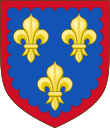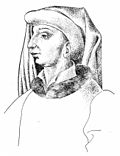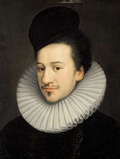The Duchy of Anjou was a French province straddling the lower Loire. Its capital was Angers, and its area was roughly co-extensive with the diocese of Angers. Anjou was bordered by Brittany to the west, Maine to the north, Touraine to the east and Poitou to the south. The adjectival form is Angevin, and inhabitants of Anjou are known as Angevins. In 1482, the duchy became part of the Kingdom of France and then remained a province of the Kingdom under the name of the Duchy of Anjou. After the decree dividing France into departments in 1790, the province was disestablished and split into six new départements: Deux-Sèvres, Indre-et-Loire, Loire-Atlantique, Maine-et-Loire, Sarthe and Vienne.

The House of Bourbon is a dynasty that originated in the Kingdom of France and is a branch of the Capetian dynasty, the royal House of France. Bourbon kings first ruled France and Navarre in the 16th century, and by the 18th century, members of the Spanish Bourbon dynasty held thrones in Spain, Naples, Sicily, and Parma. Today Spain and Luxembourg have monarchs of the House of Bourbon. The royal Bourbons originated in 1272, when Robert, the youngest son of King Louis IX of France, married the heiress of the lordship of Bourbon. The house continued for three centuries as a cadet branch, serving as nobles under the direct Capetian and Valois kings.
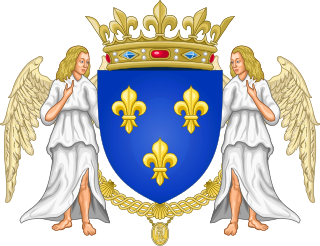
The Capetian house of Valois was a cadet branch of the Capetian dynasty. They succeeded the House of Capet to the French throne, and were the royal house of France from 1328 to 1589. Junior members of the family founded cadet branches in Orléans, Anjou, Burgundy, and Alençon.

Charles VI, nicknamed the Beloved and later the Mad, was King of France from 1380 until his death in 1422. He is known for his mental illness and psychotic episodes that plagued him throughout his life.
The count of Anjou was the ruler of the County of Anjou, first granted by Charles the Bald in the 9th century to Robert the Strong. Ingelger and his son, Fulk the Red, were viscounts until Fulk assumed the title of count. The Robertians and the Capetian kings were distracted by wars with the Vikings and other concerns and were unable to recover the county until the reign of Philip II Augustus, more than 270 years later.
An appanage, or apanage, is the grant of an estate, title, office or other thing of value to a younger child of a monarch, who would otherwise have no inheritance under the system of primogeniture. It was common in much of Europe.

Louis Alphonse de Bourbon is the head of the House of Bourbon. Members of the family formerly ruled France and other countries. According to the Legitimists, Louis Alphonse is considered the pretender to the defunct throne of France. Since the death of his father in 1989, he has used the title Duke of Anjou.

The Duke of Brabant was the ruler of the Duchy of Brabant since 1183/1184. The title was created by the Holy Roman Emperor Frederick Barbarossa in favor of Henry I of the House of Reginar, son of Godfrey III of Leuven. The Duchy of Brabant was a feudal elevation of the existing title of landgrave of Brabant. This was an Imperial fief which was assigned to Count Henry III of Leuven shortly after the death of the preceding count of Brabant, Herman II of Lotharingia. Although the corresponding county was quite small its name was applied to the entire country under control of the dukes from the 13th century on. In 1190, after the death of Godfrey III, Henry I also became duke of Lotharingia. Formerly Lower Lotharingia, this title was now practically without territorial authority, but was borne by the later dukes of Brabant as an honorific title.
Duke of Orléans was a French royal title usually granted by the King of France to one of his close relatives, or otherwise inherited through the male line. First created in 1344 by King Philip VI for his younger son Philip, the title was recreated by King Charles VI for his younger brother Louis, who passed the title on to his son and then to his grandson, the latter becoming King Louis XII. The title was created and recreated six times in total, until 1661, when Louis XIV bestowed it upon his younger brother Philippe, who passed it on to his male descendants, who became known as the "Orléans branch" of the Bourbons.
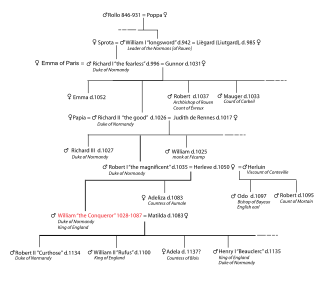
In the Middle Ages, the duke of Normandy was the ruler of the Duchy of Normandy in north-western France. The duchy arose out of a grant of land to the Viking leader Rollo by the French king Charles the Simple in 911. In 924 and again in 933, Normandy was expanded by royal grant. Rollo's male-line descendants continued to rule it until 1135. In 1202 the French king Philip II declared Normandy a forfeited fief and by 1204 his army had conquered it. It remained a French royal province thereafter, still called the Duchy of Normandy, but only occasionally granted to a duke of the royal house as an apanage.
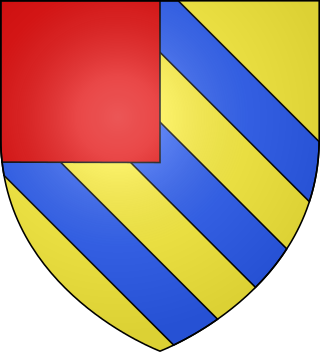
Several counts and then royal dukes of Alençon have figured in French history. The title has been awarded to a younger brother of the French sovereign.
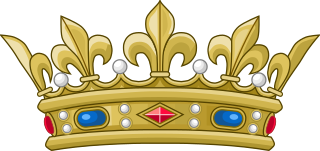
Fils de France was the style and rank held by the sons of the kings and dauphins of France. A daughter was known as a fille de France.

The 4th House of Orléans, sometimes called the House of Bourbon-Orléans to distinguish it, is the fourth holder of a surname previously used by several branches of the Royal House of France, all descended in the legitimate male line from the dynasty's founder, Hugh Capet. The house was founded by Philippe I, Duke of Orléans, younger son of Louis XIII and younger brother of Louis XIV, the "Sun King".

The Duchy of Orléanais is a former province of France, which was created during the Renaissance by merging four former counties and towns. However after the French Revolution, the province was dissolved in 1791 and succeeded by five départments.

Charles of France, Duke of Berry, was a grandson of Louis XIV of France. Although he was only a grandson of Louis XIV, Berry held the rank of fils de France, rather than petit-fils de France, as the son of the Dauphin, heir apparent to the throne. The Duke of Berry was for seven years (1700–1707) heir presumptive to the throne of Spain, until his elder brother Philip V of Spain fathered a son in 1707.

The House of Valois-Burgundy, or the Younger House of Burgundy, was a noble French family deriving from the royal House of Valois. It is distinct from the Capetian House of Burgundy, descendants of King Robert II of France, though both houses stem from the Capetian dynasty. They ruled the Duchy of Burgundy from 1363 to 1482 and later came to rule vast lands including Artois, Flanders, Luxembourg, Hainault, the county palatine of Burgundy (Franche-Comté), and other lands through marriage, forming what is now known as the Burgundian State.

A prince du sang is a person legitimately descended in male line from a sovereign. The female equivalent is princess of the blood, being applied to the daughter of a prince of the blood. The most prominent examples include members of the French royal line, but the term prince of the blood has been used in other families more generally, for example among the British royal family and when referring to the Shinnōke in Japan.

Philippe-Charles, Duke of Anjou was the fifth child and second son of King Louis XIV of France and Maria Theresa of Spain, and as such was a fils de France.
The crown lands, crown estate, royal domain or domaine royal of France were the lands, fiefs and rights directly possessed by the kings of France. While the term eventually came to refer to a territorial unit, the royal domain originally referred to the network of "castles, villages and estates, forests, towns, religious houses and bishoprics, and the rights of justice, tolls and taxes" effectively held by the king or under his domination. In terms of territory, before the reign of Henry IV, the domaine royal did not encompass the entirety of the territory of the kingdom of France and for much of the Middle Ages significant portions of the kingdom were the direct possessions of other feudal lords.

Jean Gaston d'Orléans, petit-fils de France, Duke of Valois was a French Prince and Grandson of France. He was a member of the House of Bourbon.
